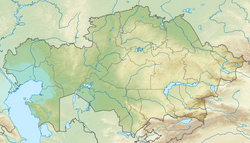Kamyshlov Log
Kamyshlov Log
Камышловский лог Камыстысай | |
|---|---|
 View of a stretch of the Kamyshlov Log in Maryanovsky District, Omsk Oblast | |
| Coordinates: 55°0′N 70°50′E / 55.000°N 70.833°E | |
| Location | Kazakhstan, Russia |
| Part of | West Siberian Plain |
| Dimensions | |
| • Length | 500 km (310 mi) |


The Kamyshlov Log (Russian: Камышловский лог or Урочище Камышловский лог;
The first geographical observations about the Kamyshlov Log in the early 18th century described it as a flowing river,[3] consisting in a chain of long lakes interconnected by channels, which seasonally dried up, but flowed again during periods of high water. However, by the 19th century most of the surrounding steppe was converted into agricultural fields and the flow between the lakes gradually stopped. The runoff along an almost imperceptible channel last took place in 1865 when the water reached the village of Poludino.[4]
Geography
The Kamyshlov Log is part of the
Bolshoy Tarangul lake at 54°02′N 68°22′E / 54.033°N 68.367°E. The trench runs first roughly northeastwards and then eastwards. It has a width between 1 kilometer (0.62 mi) and 20 kilometers (12 mi), with a depth ranging from 10 meters (33 ft) to 20 meters (66 ft).[1][2][4] The lakes are mostly shallow and some dry up in the summer. The largest are Reinfeld, Pokrovskoye, Sandy, Churino, Severnoye, Sergeevskoye, Zheltoye, Ovtsevodskoye, Krugloye and Topkoye.[5]
The
forest-steppe zones of the southern West Siberian Plain have a cyclic intervals of wet and dry spells. Historically, the average duration of a cycle is between 50 and 60 years with each high-water and low-water period lasting from 25 to 30 years. Peaks of high-water periods were observed in 1705-1715, 1750-1760, 1787-1798, 1820-1832, 1856-1870, 1910-1920, 1948-1955, 1985-1992, and peaks of dry periods in 1730-1740 , 1767-1778, 1805-1813, 1840-1853, 1875-1885, 1935-1944, 1974-1984.[6] The worst drought was recorded in the 1875-1885 period with catastrophic effects on the water bodies of the region. The water levels were so low that many lakes turned into grassy tracts or desert depressions with sparse vegetation.[7]
See also
References
- ^ a b Google Earth
- ^ a b Geographical position, geological structure and surface topography of the south of Western Siberia (in Russian)
- ^ Drawing Book of Siberia, compiled by Semyon Remezov 1701.
- ^ a b Характеристика состояния водных объектов Омской области» Архивная копия
- ^ "N-42 Topographic Chart (in Russian)". Retrieved 16 July 2022.
- ^ Statistics of the Institute of Lake Science of the Russian Academy of Sciences (Институт озероведения РАН)
- ^ "Characteristics of the state of water bodies in the Omsk region", Omsk branch of the Federal State Institution "TFGI for the Siberian Federal District" of the Federal Agency for Subsoil Use. (in Russian)
External links
 Media related to Kamyshlovsky Log at Wikimedia Commons
Media related to Kamyshlovsky Log at Wikimedia Commons- Kzyl-Agash, Russia - tourist attractions


